The global quantum cascade laser market, valued at USD 455.8 million in 2025 and projected to reach USD 1,011.8 million by 2035 at a CAGR of 8.3%, will expand unevenly across regions as demand patterns diverge based on industrial sophistication, defense spending, and technological adoption cycles. North America is expected to maintain its dominant share, driven by strong investments in defense and homeland security programs, advanced R&D in spectroscopy, and the presence of leading semiconductor laser manufacturers. The region’s established medical technology sector and extensive use of precision sensing systems in environmental monitoring will further reinforce its position, particularly as federal agencies channel resources into quantum-enabled defense applications.
Europe is likely to record steady growth as aerospace contractors, medical device firms, and energy industries expand their deployment of quantum cascade lasers for diagnostics and industrial sensing. Government-backed research programs in Germany, France, and the UK are anticipated to accelerate adoption, while EU-wide funding for quantum technologies under programs like Horizon Europe will strengthen the ecosystem. The emphasis on emission monitoring and industrial compliance is also expected to drive adoption in environmental applications.
Asia Pacific is set to emerge as the fastest-growing region, propelled by rising electronics manufacturing capabilities, expanding defense budgets, and increasing interest in photonics for telecom and medical diagnostics. Countries like China, Japan, and South Korea are investing heavily in quantum research, with China advancing rapidly in dual-use defense and industrial laser applications. The region’s manufacturing base is expected to boost large-scale adoption, particularly in spectroscopy and process control.
The Middle East will likely see moderate uptake, mostly linked to defense modernization projects and oil & gas sector monitoring, while Latin America is projected to remain a small but gradually expanding market, with opportunities in medical testing and industrial safety monitoring.
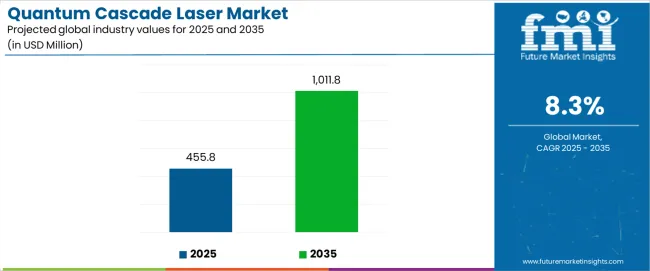
Between 2025 and 2030, the quantum cascade laser market is projected to expand from USD 455.8 million to USD 679.1 million, resulting in a value increase of USD 223.3 million, which represents 40.2% of the total forecast growth for the decade. This phase of development will be shaped by increasing demand for precision sensing solutions, rising nanotechnology activity enabling advanced quantum applications, and growing availability of compact laser systems across medical diagnostic operations and industrial monitoring facilities.
Between 2030 and 2035, the quantum cascade laser market is forecast to grow from USD 679.1 million to USD 1,011.8 million, adding another USD 332.7 million, which constitutes 59.8% of the overall ten-year expansion. This period is expected to be characterized by the advancement of integrated quantum systems, the integration of ai-driven control algorithms for laser optimization, and the development of premium frequency-tunable lasers across diverse sensing applications. The growing emphasis on quantum technology advancement and photonic integration will drive demand for advanced laser varieties with enhanced power efficiency capabilities, improved beam quality characteristics, and superior spectral performance profiles.
Between 2020 and 2024, the quantum cascade laser market experienced accelerated growth, driven by increasing defense spending and growing recognition of quantum technology's effectiveness in delivering precise spectral analysis across chemical detection and environmental monitoring applications. The quantum cascade laser market developed as researchers recognized the potential for advanced quantum cascade systems to deliver operational precision while meeting modern requirements for molecular identification and high-resolution spectroscopic measurements. Technological advancement in quantum well engineering and cascade structure design began emphasizing the critical importance of maintaining frequency stability while enhancing optical power output and improving detection sensitivity across wavelength ranges.
| Metric | Value |
|---|---|
| Estimated Value in (2025E) | USD 455.8 million |
| Forecast Value in (2035F) | USD 1,011.8 million |
| Forecast CAGR (2025 to 2035) | 8.30% |
From 2030 to 2035, the quantum cascade laser market is forecast to grow from USD 679.1 million to USD 1,011.8 million, adding another USD 332.7 million, which constitutes 59.8% of the overall ten-year expansion. This period is expected to be characterized by the advancement of digital wavelength control systems, the integration of automated thermal management accessories for performance optimization, and the development of specialized quantum structures for enhanced emission characteristics. The growing emphasis on system miniaturization and operational versatility will drive demand for premium varieties with enhanced thermal stability credentials, improved frequency tuning options, and superior reliability characteristics.
Between 2020 and 2024, the quantum cascade laser market experienced robust growth, driven by increasing awareness of quantum photonics benefits and growing recognition of cascade laser systems' effectiveness in supporting efficient detection operations across defense installations and medical diagnostic services. The quantum cascade laser market developed as users recognized the potential for specialized quantum cascade devices to deliver performance advantages while meeting modern requirements for precise wavelength control and reliable laser operation. Technological advancement in epitaxial growth processes and quantum engineering systems began emphasizing the critical importance of maintaining emission purity while extending laser operational life and improving measurement accuracy across diverse spectroscopic applications.
Market expansion is being supported by the increasing global demand for advanced spectroscopy solutions and the corresponding shift toward high-performance quantum laser systems that can provide superior analytical characteristics while meeting user requirements for precision detection and cost-effective measurement processes. Modern researchers are increasingly focused on incorporating quantum cascade systems that can enhance analytical capabilities while satisfying demands for precise, highly controlled emission wavelengths and optimized detection sensitivity practices. Quantum cascade lasers' proven ability to deliver spectral precision, chemical identification accuracy, and diverse application possibilities makes them essential components for analytical laboratories and quality-conscious research professionals.
The growing emphasis on molecular detection and quantum technology optimization is driving demand for high-performance quantum cascade systems that can support distinctive analytical outcomes and comprehensive detection capabilities across chemical analysis, environmental monitoring, and biomedical sensing applications. User preference for lasers that combine functional excellence with operational flexibility is creating opportunities for innovative implementations in both traditional and emerging quantum applications. The rising influence of automated detection processes and advanced quantum technologies is also contributing to increased adoption of specialized quantum cascade lasers that can provide authentic performance benefits and reliable operational characteristics.
The quantum cascade laser market is segmented by product type, application, wavelength range, power output, and region. By product type, the quantum cascade laser market is divided into quantum well QCL, superlattice QCL, distributed feedback QCL, external cavity QCL, and others. Based on application, the quantum cascade laser market is categorized into nanotechnology, communication, medical, national defense, and others. By wavelength range, the quantum cascade laser market includes mid-infrared, far-infrared, terahertz range, and custom wavelengths. By power output, the quantum cascade laser market encompasses low-power, medium-power, high-power, and ultra-high-power systems. Regionally, the quantum cascade laser market is divided into North America, Europe, Asia Pacific, Latin America, the Middle East & Africa, and other regions.
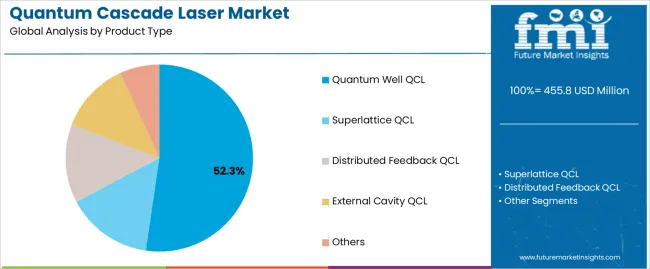
The quantum well QCL segment is projected to account for 52.3% of the quantum cascade laser market in 2025, reaffirming its position as the leading product category. Researchers and quantum technology professionals increasingly utilize quantum well QCL systems for their superior emission characteristics, established performance standards, and essential functionality in diverse analytical applications across multiple research domains. Quantum well QCL systems' proven spectral characteristics and established cost-effectiveness directly address user requirements for reliable laser operation and optimal detection precision in laboratory applications.
This product segment forms the foundation of modern quantum cascade laser performance patterns, as it represents the component category with the greatest analytical impact potential and established compatibility across multiple detection systems. Research investments in advanced quantum engineering and performance optimization continue to strengthen adoption among precision-conscious scientists. With users prioritizing emission stability and detection reliability, quantum well QCL systems align with both analytical objectives and quality requirements, making them the central component of comprehensive spectroscopic strategies.
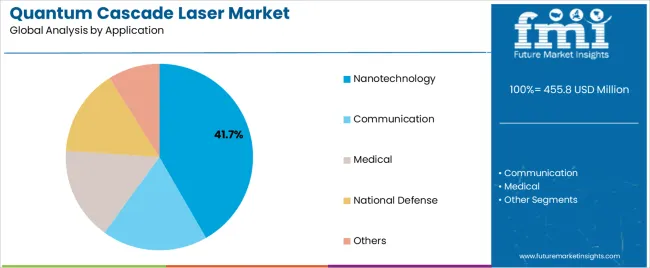
Nanotechnology is projected to represent 41.7% of the quantum cascade laser market in 2025, underscoring its critical role as the primary application for quality-focused researchers seeking superior analytical efficiency benefits and enhanced measurement precision credentials. Research scientists and nanotechnology professionals prefer nanotechnology applications for their established measurement requirements, proven analytical demand, and ability to maintain exceptional spectral resolution while supporting versatile detection capabilities during diverse research projects. Positioned as essential applications for precision-conscious researchers, nanotechnology offerings provide both operational excellence and competitive positioning advantages.
The segment is supported by continuous improvement in quantum technology and the widespread availability of established measurement standards that enable quality assurance and premium positioning at the research level. Additionally, nanotechnology companies are optimizing laser selections to support project differentiation and competitive analysis strategies. As quantum technology continues to advance and researchers seek efficient detection methods, nanotechnology applications will continue to drive market growth while supporting research development and analytical precision strategies.
The quantum cascade laser market is advancing rapidly due to increasing quantum technology consciousness and growing need for precision detection solutions that emphasize superior analytical outcomes across nanotechnology segments and medical applications. However, the quantum cascade laser market faces challenges, including competition from alternative laser technologies, thermal management complexities, and component cost pressures affecting operational economics. Innovation in quantum structure integration and advanced materials continues to influence market development and expansion patterns.
The growing adoption of quantum cascade lasers in medical diagnostics and defense applications is enabling researchers to develop analytical strategies that provide distinctive precision benefits while commanding competitive positioning and enhanced measurement accuracy characteristics. Medical applications provide superior detection sensitivity while allowing more sophisticated analytical features across various diagnostic categories. Users are increasingly recognizing the operational advantages of quantum positioning for premium analytical outcomes and precision-conscious research integration.
Modern quantum cascade laser manufacturers are incorporating advanced control algorithms, ai-driven wavelength optimization systems, and automated performance tracking to enhance operational precision, improve system reliability, and meet commercial demands for intelligent quantum solutions. These systems improve analytical effectiveness while enabling new applications, including predictive maintenance programs and performance optimization protocols. Advanced AI integration also allows researchers to support analytical leadership positioning and quality assurance beyond traditional detection operations.
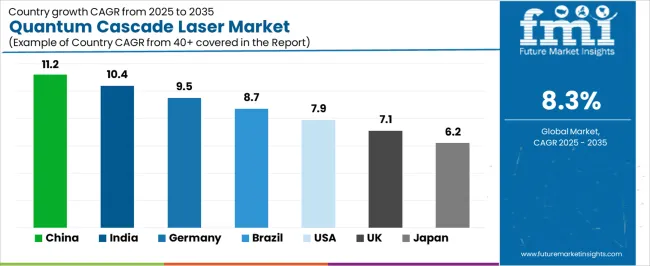
| Country | CAGR (2025-2035) |
|---|---|
| China | 11.2% |
| India | 10.4% |
| Germany | 9.5% |
| Brazil | 8.7% |
| USA | 7.9% |
| UK | 7.1% |
| Japan | 6.2% |
The quantum cascade laser market is experiencing robust growth globally, with China leading at an 11.2% CAGR through 2035, driven by the expanding quantum technology sector, growing defense research requirements, and increasing adoption of advanced spectroscopy systems. India follows at 10.4%, supported by rising nanotechnology development, expanding research infrastructure, and growing acceptance of quantum detection solutions. Germany shows growth at 9.5%, emphasizing established photonics capabilities and comprehensive quantum technology development. Brazil records 8.7%, focusing on research expansion and medical diagnostic growth. The USA demonstrates 7.9% growth, prioritizing advanced quantum technologies and defense optimization.
The report covers an in-depth analysis of 40+ countries; seven top-performing countries are highlighted below.
Revenue from quantum cascade laser consumption and sales in China is projected to exhibit exceptional growth with a CAGR of 11.2% through 2035, driven by the country's rapidly expanding quantum technology sector, favorable government policies toward quantum research development, and initiatives promoting advanced photonics technologies across major research regions. China's position as a leading quantum technology hub and increasing focus on quantum cascade systems are creating substantial demand for high-quality quantum cascade lasers in both domestic and export markets. Major research institutions and technology companies are establishing comprehensive quantum capabilities to serve growing demand and emerging market opportunities.
Revenue from quantum cascade laser products in India is expanding at a CAGR of 10.4%, supported by rising research investment, growing quantum technology development, and expanding analytical capabilities. The country's developing quantum sector and increasing commercial investment in advanced photonics technologies are driving demand for quantum cascade lasers across both traditional and modern detection applications. International quantum companies and domestic distributors are establishing comprehensive operational networks to address growing market demand for quality lasers and efficient detection solutions.
Revenue from quantum cascade laser products in Germany is projected to grow at a CAGR of 9.5% through 2035, supported by the country's mature photonics sector, established quantum standards, and leadership in laser technology. Germany's sophisticated research infrastructure and strong support for advanced quantum systems are creating steady demand for both traditional and innovative laser varieties. Leading photonics manufacturers and specialty distributors are establishing comprehensive operational strategies to serve both domestic markets and growing export opportunities.
Revenue from quantum cascade laser products in Brazil is projected to grow at a CAGR of 8.7% through 2035, driven by the country's emphasis on research expansion, quantum technology development, and growing analytical capabilities. Brazilian researchers and technology companies consistently seek commercial-grade lasers that enhance project efficiency and support operational excellence for both traditional and modern detection applications. The country's position as a Latin American quantum leader continues to drive innovation in specialized laser applications and commercial technology standards.
Revenue from quantum cascade laser products in the USA is projected to grow at a CAGR of 7.9% through 2035, supported by the country's emphasis on defense technology advancement, quantum optimization, and advanced detection integration requiring efficient laser solutions. American researchers and defense organizations prioritize performance reliability and analytical precision, making specialized quantum cascade lasers essential components for both traditional and modern detection applications. The country's comprehensive defense leadership and advancing quantum patterns support continued market expansion.
Revenue from quantum cascade laser products in the UK is projected to grow at a CAGR of 7.1% through 2035, supported by established quantum standards, mature research markets, and emphasis on system reliability across academic and defense sectors. British researchers and quantum professionals prioritize quality performance and operational consistency, creating steady demand for premium laser solutions. The country's comprehensive market maturity and established quantum practices support continued development in specialized applications.
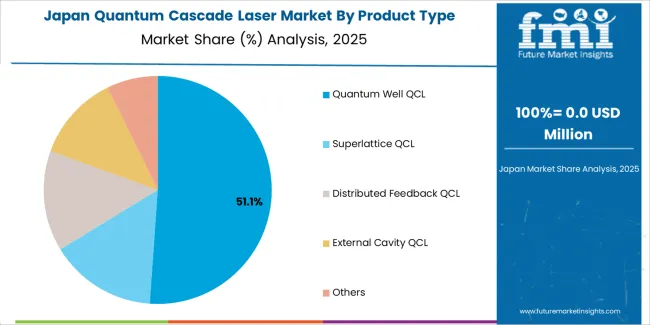
Revenue from quantum cascade laser products in Japan is projected to grow at a CAGR of 6.2% through 2035, supported by the country's emphasis on precision manufacturing, quality excellence, and advanced quantum integration requiring efficient laser solutions. Japanese businesses and research organizations prioritize technical performance and manufacturing precision, making specialized quantum cascade lasers essential components for both traditional and modern detection applications. The country's comprehensive quality leadership and advancing quantum patterns support continued market expansion.
The Europe quantum cascade laser market is projected to grow from USD 133.7 million in 2025 to USD 296.8 million by 2035, recording a CAGR of 8.3% over the forecast period. Germany leads the region with a 38.2% share in 2025, moderating slightly to 37.6% by 2035, supported by its strong photonics base and demand for premium, technically advanced quantum laser systems. The United Kingdom follows with 26.1% in 2025, easing to 25.7% by 2035, driven by a mature research market and emphasis on system reliability and performance optimization.
France accounts for 15.8% in 2025, rising to 16.3% by 2035, reflecting steady adoption of automated quantum solutions and operational efficiency enhancement. Italy holds 9.4% in 2025, expanding to 10.1% by 2035 as medical diagnostics and specialty quantum applications grow. Spain contributes 5.2% in 2025, growing to 5.4% by 2035, supported by expanding research sector and technology modernization. The Nordic countries rise from 3.7% in 2025 to 3.9% by 2035 on the back of strong quantum adoption and advanced detection methodologies. BENELUX remains at 1.6% share across both 2025 and 2035, reflecting mature, efficiency-focused research markets.
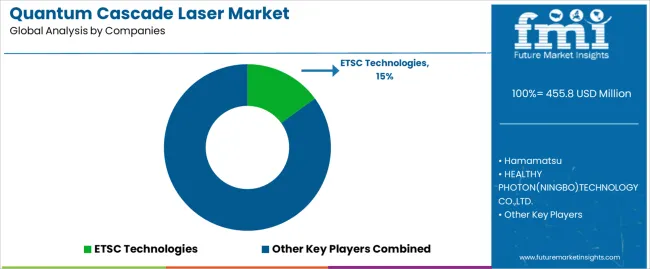
The quantum cascade laser market is characterized by competition among established photonics manufacturers, specialized quantum technology producers, and integrated detection solution companies. Companies are investing in precision quantum engineering technologies, advanced epitaxial growth systems, product innovation capabilities, and comprehensive distribution networks to deliver consistent, high-quality, and reliable quantum cascade laser systems. Innovation in wavelength optimization, thermal management enhancement, and application-specific product development is central to strengthening market position and customer satisfaction.
ETSC Technologies leads the quantum cascade laser market with a strong focus on quantum technology innovation and comprehensive quantum cascade laser solutions, offering commercial laser systems with emphasis on manufacturing excellence and technological heritage. Hamamatsu provides specialized photonics products with a focus on research market applications and precision engineering networks. HEALTHY PHOTON(NINGBO)TECHNOLOGY CO., LTD. delivers integrated quantum solutions with a focus on researcher positioning and operational efficiency. Pranalytica specializes in comprehensive quantum cascade systems with an emphasis on defense applications. SpectraLine focuses on comprehensive analytical quantum lasers with advanced design and premium positioning capabilities.
The success of quantum cascade lasers in meeting commercial detection demands, researcher-driven precision requirements, and performance integration will not only enhance analytical quality outcomes but also strengthen global quantum technology capabilities. It will consolidate emerging regions' positions as hubs for efficient quantum production and align advanced economies with commercial detection systems. This calls for a concerted effort by all stakeholders - governments, industry bodies, manufacturers, distributors, and investors. Each can be a crucial enabler in preparing the quantum cascade laser market for its next phase of growth.
| Items | Values |
|---|---|
| Quantitative Units (2025) | USD 455.8 million |
| Product Type | Quantum Well QCL, Superlattice QCL, Distributed Feedback QCL, External Cavity QCL, Others |
| Application | Nanotechnology, Communication, Medical, National Defense, Others |
| Wavelength Range | Mid-Infrared, Far-Infrared, Terahertz Range, Custom Wavelengths |
| Power Output | Low Power Systems, Medium Power Systems, High Power Systems, Ultra-High Power Systems |
| Regions Covered | North America, Europe, Asia Pacific, Latin America, Middle East & Africa, Other Regions |
| Countries Covered | China, India, Germany, Brazil, United States, United Kingdom, Japan, and 40+ countries |
| Key Companies Profiled | ETSC Technologies, Hamamatsu, HEALTHY PHOTON(NINGBO)TECHNOLOGY CO.,LTD., Pranalytica, SpectraLine, and other leading quantum cascade laser companies |
| Additional Attributes | Dollar sales by product type, application, wavelength range, power output, and region; regional demand trends, competitive landscape, technological advancements in quantum engineering, precision manufacturing initiatives, wavelength optimization programs, and premium product development strategies |
The global quantum cascade laser market is estimated to be valued at USD 455.8 million in 2025.
The market size for the quantum cascade laser market is projected to reach USD 1,011.8 million by 2035.
The quantum cascade laser market is expected to grow at a 8.3% CAGR between 2025 and 2035.
The key product types in quantum cascade laser market are quantum well qcl, superlattice qcl, distributed feedback qcl, external cavity qcl and others.
In terms of application, nanotechnology segment to command 41.7% share in the quantum cascade laser market in 2025.






Full Research Suite comprises of:
Market outlook & trends analysis
Interviews & case studies
Strategic recommendations
Vendor profiles & capabilities analysis
5-year forecasts
8 regions and 60+ country-level data splits
Market segment data splits
12 months of continuous data updates
DELIVERED AS:
PDF EXCEL ONLINE
Quantum Cascade Lasers Market Growth - Trends & Forecast 2025 to 2035
Quantum Detector Market Size and Share Forecast Outlook 2025 to 2035
Quantum Imaging Devices Market Analysis - Size, Share, and Forecast Outlook 2025 to 2035
Quantum Sensors Market Size and Share Forecast Outlook 2025 to 2035
Quantum Computing Market Growth – Trends & Forecast 2025 to 2035
Quantum Cryptography Market Insights - Growth & Forecast 2025 to 2035
Quantum Dot Market Analysis by Application, End-Use Industry, Material Type, Technology, and Region Through 2035
Quantum Photonics Market Analysis – Growth & Forecast 2024-2034
Post-Quantum Cryptography (PQC) Migration Market Analysis - Size, Share, and Forecast Outlook 2025 to 2035
Automotive Quantum Computing Market Size and Share Forecast Outlook 2025 to 2035
Integrated Quantum Optical Circuits Market Size and Share Forecast Outlook 2025 to 2035
ADC & DAC In Quantum Computing Market Size and Share Forecast Outlook 2025 to 2035
Superconducting Quantum Chip Market Size and Share Forecast Outlook 2025 to 2035
Photonic Integrated Circuit & Quantum Computing Market - Trends & Forecast 2025 to 2035
Anderson Cascade Impactor Market Size and Share Forecast Outlook 2025 to 2035
Laser Welding Equipment Market Forecast and Outlook 2025 to 2035
Laser Welding Market Size and Share Forecast Outlook 2025 to 2035
Laser Ablation Systems Market Size and Share Forecast Outlook 2025 to 2035
Laser Measurement Integrating Sphere Market Size and Share Forecast Outlook 2025 to 2035
Laser Safety Cloths Market Size and Share Forecast Outlook 2025 to 2035

Thank you!
You will receive an email from our Business Development Manager. Please be sure to check your SPAM/JUNK folder too.
Chat With
MaRIA